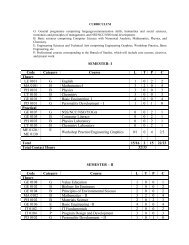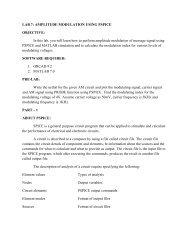Approaches' for parenteral controlled drug administration:
Approaches' for parenteral controlled drug administration:
Approaches' for parenteral controlled drug administration:
You also want an ePaper? Increase the reach of your titles
YUMPU automatically turns print PDFs into web optimized ePapers that Google loves.
1<br />
UNIT VII<br />
APPROACHES FOR PARENTERAL<br />
CONTROLLED DRUG ADMINISTRATION<br />
V.MANIMARAN<br />
LECTURER<br />
DEPARTMENT OF PHARMACEUTICS<br />
SRM COLLEGE OF PHARMACY
Approaches <strong>for</strong> <strong>parenteral</strong> <strong>controlled</strong><br />
<strong>drug</strong> <strong>administration</strong>:<br />
2<br />
Several pharmaceutical <strong>for</strong>mulation approaches may be<br />
applied to the development of parental <strong>controlled</strong><br />
release or sustained release <strong>for</strong>mulations.<br />
The most commonly used techniques are as follows:<br />
‣ Use of viscous, water miscible vehicles such as an<br />
aqueous solution of gelatin or poly vinyl pyrrolidine.<br />
‣ Formation of thixotropic suspensions.
3<br />
‣ Use of water immiscible vehicles such as vegetable<br />
oil or water repelling agent such as aluminium mono<br />
stearate.<br />
‣ Preparation of water insoluble <strong>drug</strong> derivatives such<br />
as salts, complexes and esters.<br />
‣ Dispersion in polymeric micro spheres or<br />
microcapsules such as lactide glycolide<br />
homopolymer or copolymers.<br />
‣ Co-<strong>administration</strong> of vaso constrictors.
4<br />
Depot <strong>for</strong>mulation may be classified on the basis of<br />
the process used <strong>for</strong> <strong>controlled</strong> <strong>drug</strong> release as<br />
follows:
5<br />
Two approaches to control dissolution<br />
a) Formation of salt or complexes with low aqueous<br />
solubility:<br />
E.g. Aqueous suspensions of benzathine penicillin G<br />
from water soluble alkali salts of acidic pencillin G.<br />
b) Suspension of macrocrystals:<br />
large crystals are known to dissolve more slowly<br />
than small crystals. It is called ‘the macro crystal principle’<br />
and can be applied to control the rate of <strong>drug</strong> dissolution.<br />
Eg: aqueous suspension of testosterone isobutyrate <strong>for</strong><br />
I.M injection<br />
Exception : Penicillin G procaine suspension in gelled<br />
peanut oil <strong>for</strong> I.M. injection.
6<br />
The major drawback of these two types of injectables<br />
depot <strong>for</strong>mulations is that the release of <strong>drug</strong> molecules<br />
is not of zero order kinetics as expected from the<br />
theoretical model defined in the equation.<br />
Reasons:<br />
‣ surface area of the <strong>drug</strong> solids diminishes with time<br />
because of increased <strong>drug</strong> release<br />
‣ saturation solubility of the <strong>drug</strong> in the medium cannot<br />
be maintained easily because of rapid absorption.
7<br />
2)ADSORPTION TYPE DEPOT FORMULATION:<br />
This type of depot preparation is <strong>for</strong>med by the binding<br />
of <strong>drug</strong> molecule to adsorbents.<br />
In this only the unbound, free species of the <strong>drug</strong> is<br />
available <strong>for</strong> adsorption.<br />
As soon as the unbound <strong>drug</strong> molecule are absorbed, a<br />
fraction of the bound <strong>drug</strong> molecule is released to<br />
maintain equilibrium.<br />
<br />
E.g. vaccine preparations.
8<br />
3)ENCAPSULATION TYPE DEPOT FORMULATIONS:<br />
This type of depot <strong>for</strong>mulation is prepared by<br />
encapsulating <strong>drug</strong> solids within a permeation barrier or<br />
dispersing <strong>drug</strong> particles in a diffusion matrix.<br />
Both of these are made from either bio-degradable or bioabsorbable<br />
polymers.<br />
Release of <strong>drug</strong> is <strong>controlled</strong> by<br />
‣ rate of penetration across the diffusion barrier<br />
‣ rate of biodegradation of the barrier macro molecules.<br />
Eg: naltrexone pamoate releasing biodegradable micro<br />
capsules
9<br />
4)ESTERFICATION TYPE DEPOT FORMULATION:<br />
This depot preparation is produced by synthesizing the<br />
bio-erodible esters of a <strong>drug</strong> and then making up an<br />
injectable <strong>for</strong>mulation.<br />
This <strong>for</strong>mulation <strong>for</strong>ms a <strong>drug</strong> reservoir at the site of<br />
injection.<br />
<br />
Rate of absorption is <strong>controlled</strong> by<br />
‣ interfacial partitioning of <strong>drug</strong> esters from reservoir to tissue<br />
fluid.<br />
‣ Rate of bioconversion of <strong>drug</strong> esters to regenerate active <strong>drug</strong><br />
molecules.<br />
Eg: fluphenazine enanthate, testosterone 17 β cypionate<br />
in oleaginous solution.
References:<br />
10<br />
Novel Drug Delivery Systems by Yie.W. Chien,2 nd<br />
edition, Pg. no : 381 to 385.<br />
Google search



